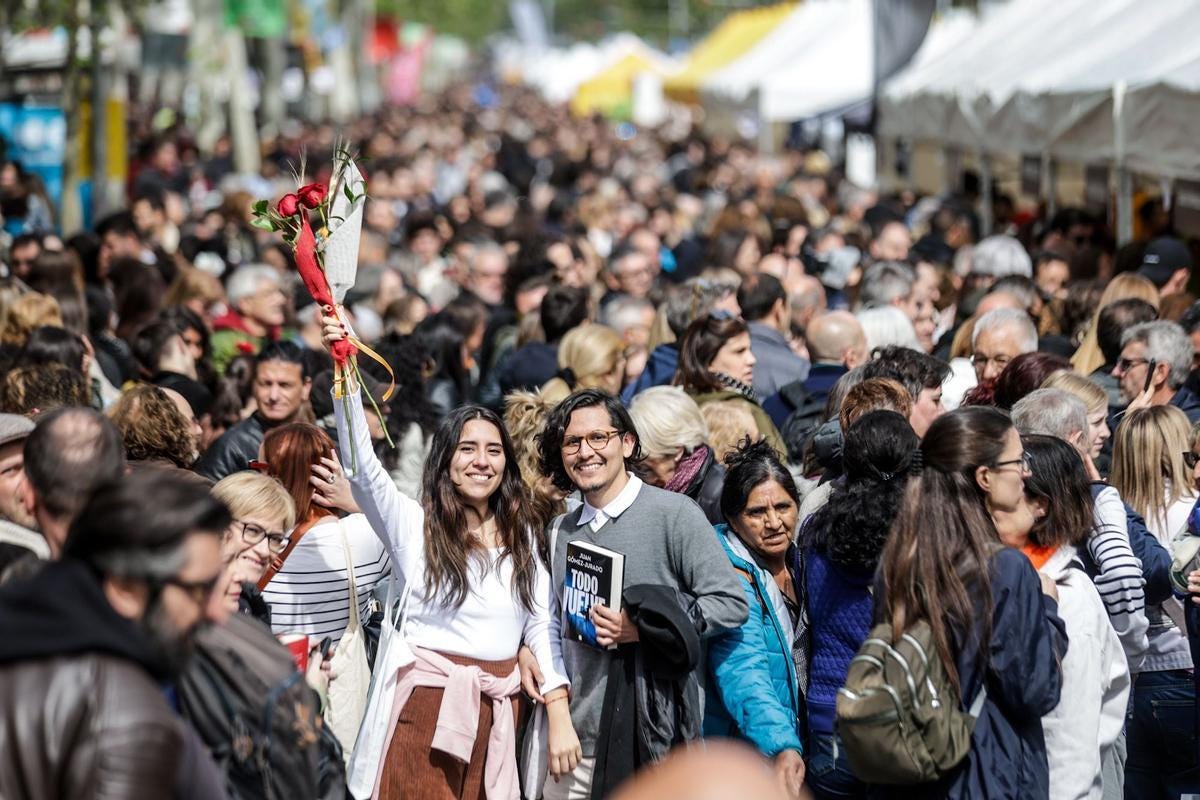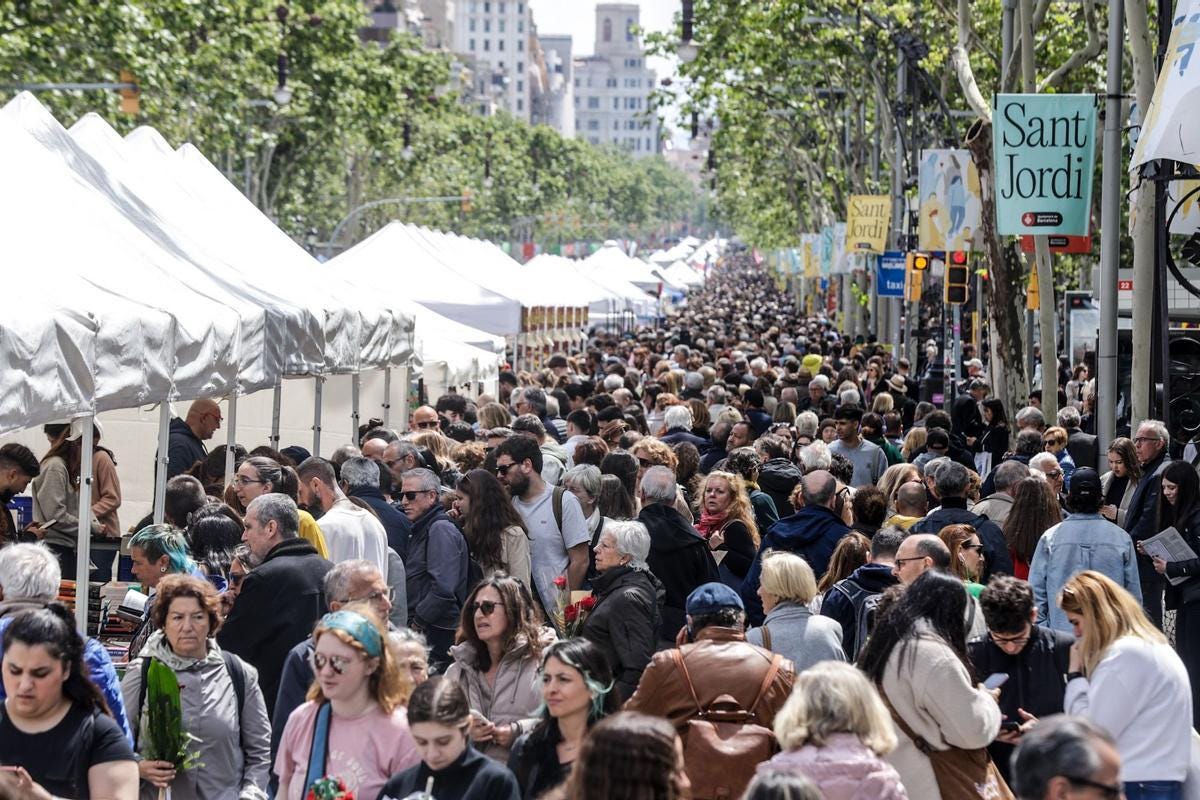Sant Jordi, an Old Catalan Tradition with New Emblematic Food
How some Catalan chefs tried to promote new culinary “classics” to honor the national day of Love and Literature
Sant Jordi is probably my favorite celebration back home in Catalonia. As most, it has a religious origin but it now has become a day to cherish love and literature. You can say it’s like Valentine’s Day if for Valentine’s you just gifted roses and books.
Sant Jordi is the patron saint of Catalonia, and its feast day is celebrated every 23 April. “Patron saint” is a literal translation to santo patrón o sant patró, but it’s a difficult concept to explain to someone foreign to it. In the Christian context, it basically means a saint that has a special affinity to a group of people or a community. There’s a patron for almost every profession, and also for regional communities. Believers think that their patron gives them special protection, and you can pray to each individual one for favors.
A Medieval legend
Curiously, Sant Jordi — or Saint George, in this case — is also the patron of the English. Which is another thing that we have in common my husband and I, even if we are both atheists. According to popular tradition, it is believed that Sant Jordi was a roman militar born in Capadocia in the 3rd century who refused to follow the orders of emperor Diocletian to persecute Christians. This led him to be martirized and beheaded on a 23 April. Soon he started being revered as a martyr and fantastic legends appeared around his figure. One of which became very popular all around Europe in the 9th century and was immortalised in the book Legenda sanctorum (1264) by the archebishop of Genoa.
In the forementioned book, the feat I am about to tell you happened in Lybia, but in Catalonia we believe it ocurred right within our borders, in a small village called Montblanc.
It is said that once upon a time there was a small Catalan village that was awestruck by the presence of a fearsome dragon. To calm its rage and avoid a massacre, the village decided to sacrifice one person a day, chosen randomly. This way, the beast was appeased and didn’t destroy the whole community. One day it fell to the king's daughter to be sent to the dragon's lair. The king begged the people to spare the princess, but he was not the only grieving father, so the lady left to face her destiny.
But right before the deadful time arrived, a noble knight appeared, confronted the dragon and ran it through with his sword, killing it and saving the princess from her tragic fate. According to the legend, where the blood of the dragon dripped on the floor, a rose bush grew, and the knight gifted one precious flower to the princess. This legend, which varies slightly in different countries but it’s quite extended throughout Europe, started a tradition to gift a rose to a dear lady on 23 April.

In 1456, Sant Jordi became the patron saint of Catalonia. At the end of the 19th century, driven by la Renaixença — a Catalan political movement that looked back to the past to encapsulate a national identity—, 23 April became a patriotic day. Men would gift a red rose to their beloved, and so the day got associated with love. In 1923, a Catalan polititian put forward an initiative to commemorate the anniversary and the death of Miguel de Cervantes. That day was stablished to be 23 April and it would be called “la Diada del Llibre” (“The day of the book”). In 1995, the UNESCO also proclaimed 23 April as the World Book and Copyright Day, as it coincides with the death of not only Cervantes but also Shakespeare and Garcilaso de la Vega.
This is how, for Catalans, 23 April became the day of love, literature and Catalanity, all at the same time.

A new beloved tradition
In Catalonia, school boys and girls make drawings of dragons, knights and princesses, and write stories for Sant Jordi. In my school, we had a literary contest in which we had to present our creations on the day of, and we would collectively choose the best story and receive prizes.
For authors, Sant Jordi is perhaps the biggest day of the year, as there are lots of events organized around newly released publications, book signings and lots of book stalls in every major and minor Catalan street. Towns and cities are also filled with the smell of roses, and even if it’s now a very money-oriented setup in which you pay a minimum of 5€ (per rose!), it’s still a beautiful sight. Books and flowers: there cannot be a better celebration.
Traditionally, a man would buy a rose to their partner, daughter and mother and receive a book from each of them. You can imagine, if a rose is 5€, a book is at a minimum double that! For financial, and igualitary reasons, nowadays, anyone can gift and receive either.
One of my favorite childhood memories is actually walking with my grandma to the main square of my hometown that was full of book stalls for Sant Jordi and picking a book of my chosing. There would be hundreds of people, and it was difficult to see what was on the tables being offered, but it was an exhiliatering experience. For years, I knew I had a book guaranteed, though. The new release of Harry Potter was ordered weeks in advance so I could receive it fresh for Sant Jordi.

Food getting its foot in
So far you’ve seen this is a day for love, flowers and books. Food doesn’t have much to do with it. Or does it?
In Catalonia, as it happens with the rest of Spain and southern Europe, we hardly celebrate anything if there’s no food involved. But unlike many other traditional days that have a specific food linked to them (see all the Catalan recipes I have been sharing here), this one doesn’t. For Sant Josep we eat crema catalana, for Lent bunyols, for Sant Joan coca, for Christmas escudella and for Sant Esteve canelons. And for Sant Jordi?
This question was solved by some chefs that created two recipes that very quickly have caught up and have become culinary synonyms of the celebration.
Pastís de Sant Jordi
The first one is the pastís de Sant Jordi (Sant Jordi’s cake). It was created by a bakery in Barcelona, Casa Riera —no longer open—, at the beginning of the 20th century. It is said that it was such a hit that the following year most bakeries had their own version.
It’s a rectangular layered sponge cake that combines butter and chocolate fillings, representing the look of a book. On top, it’s covered by caramelised egg yolk — reminiscent to the golden color in the Catalan flag— and timely decorations.
Pà de Sant Jordi
The second creation is much more recent, and it was developed in 1988 by another Barcelona bakery: Fleca Balmes. This one is a stronger hint to the Catalan flag as it plays with the yellow and redish colors present in it, to create stripes on the bread. It’s a delicious loaf filled with walnuts, cheese and sobrassada (a typical Mallorcan paprika pork sausage), that when sliced, shows the colorful stripes.
In this case, it was not an immaginative creation of the owner of the bakehouse, Eduard Crespo, but a direct assignment from the “Gremi de Flequers de Barcelona” (The Bakers' Guild of Barcelona), that wanted a bread to contribute to the celebration.
It now has become a classic of the day, and every year there are contests to choose the best Sant Jordi bread of Catalonia.

People don’t make any of these at home, but they may buy them to share with the family, or have them served at a restaurant if they are eating out for Sant Jordi. Catalonia being a land of culinary innovation, there are other chefs that have introduced more modern alternatives for a Sant Jordi food homage, like a rose ice cream created by chef Jordi Roca for his ice cream store Rocambolesc. But they may just be emphimorous sights.
I don’t know if pastís and pà de Sant Jordi will hold the test of time and become real culinary classics, associated with this beautiful feast, as many others have done throughout the history. We will not witness it, but we can still munch on a slice of pà de Sant Jordi, rose in hand, while we queue to buy a new book to read. That’s a pleasure that this year, after many not being in Barcelona for the day, I have given myself.






